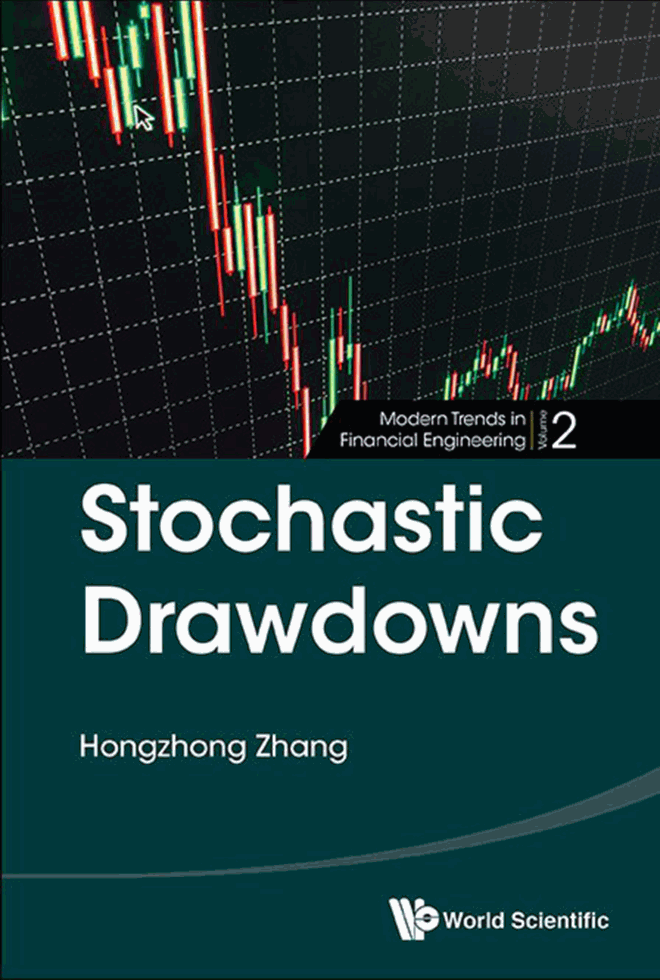
This research monograph is the second volume in World Scientific’s Modern Trends in Financial Engineering series. The aim is to combine new mathematics with practical financial insights—namely, a rigorous applied probability treatment of topics linked to trading. Probabilistic techniques are used to study market crashes (drawdowns) and time in distress (occupation times). Applications discussed include hedging and insurance against large price drops and an applied probability treatment of common loss-reduction strategies employed by proprietary traders and retail investors alike.
As defined in this book, and in an increasingly rich (and growing) applied probability literature, drawdowns are defined to be equal the difference between the current realisation of a stochastic process and the running maximum. The subject thus shares its roots with classical studies of the ladder heights of random walks (Feller Citation1971). Relatedly, a draw-up can be calculated as the difference between the current realisation of a stochastic process and the running minimum. Note, however, alternative definitions of drawdowns are sometimes used in applied work (see e.g. Johansen and Sornette Citation2010).
The book is split into two parts. Part I discusses the probabilistic properties of drawdowns and related phenomena. Topics discussed include the co-evolution of drawdowns and draw-ups, drawdowns and the speed of market crashes in diffusion models, the frequency of drawdowns in a Brownian motion model and the study of occupation times under both diffusion and Lévy models. Part II of the book discusses detailed financial applications. Topics discussed include using options to insure against drawdowns, evaluating fair premiums for drawdown insurance and optimal trading using a trailing stop, where a trailing stop is defined as an increasing function of the running maximum. This mimics approaches common amongst both proprietary traders and retail investors to limit losses.
This is a very scholarly work, albeit one where the notation and writing style can be hard to follow in places. The book also presupposes an advanced level of prior knowledge on the part of the reader and in places is under-referenced. For instance, there are no background references given to the elementary lemmas in Chapter 2 which raises concerns about how well the book could appeal to non-experts or be used by new PhD students. The appendix is too brief and is clumsily written.
Whilst it is pleasing to see such an important subject given a rigorous applied probability treatment, I have some concerns regarding the ultimate applicability of some of the methods covered. For instance, in a world dominated by High-Frequency Traders and Flash Crashes, results on the speed of market crashes in diffusion models may be seen to hold limited relevance. Perhaps High-Frequency Trading and Flash Crashes could be discussed at more length in a second edition?
I have further concerns about the extent to which classical risk-neutral approaches can be expected to apply to insurance problems involving drawdowns and extreme behaviour as this is likely to be precisely where such models begin to break down. Inter alia important real-world complications must surely include attitudes to risk, transaction costs, liquidity concerns, High-Frequency Trading, etc. However, these concerns notwithstanding, it is obviously important that these extreme insurance problems are studied, and the author is to be congratulated for including this material.
In summary, this is a very scholarly book that addresses important issues and presents a natural extension of classical probabilistic results to an applied mathematical finance setting. However, necessarily, this book is not one for the mathematically faint of heart!
Additional information
Notes on contributors
John Fry
John Fry is Senior Lecturer in Financial Mathematics and Statistics at Manchester Metropolitan University. John specialises in mathematical finance, econophysics, operations research and mathematical and statistical applications in economics and business. John has a PhD in Mathematical Finance from the University of Sheffield and has previously lectured at Nottingham Trent, Sheffield and Sheffield Hallam universities.
References
- Feller, W., An Introduction to Probability Theory and its Applications, Vol. 2, 2nd ed., 1971 (John Wiley & Sons, Inc: New York).
- Johansen, A. and Sornette, D., Shocks, crashes and bubbles in financial markets. Brussels Econ. Rev., 2010, 53, 201–253.
